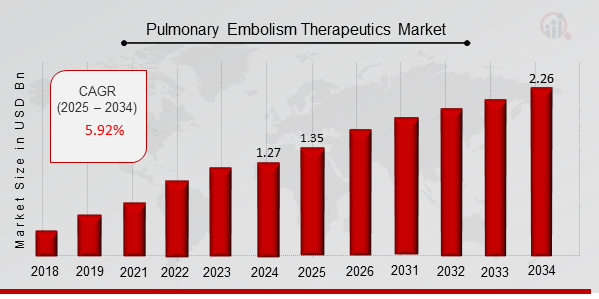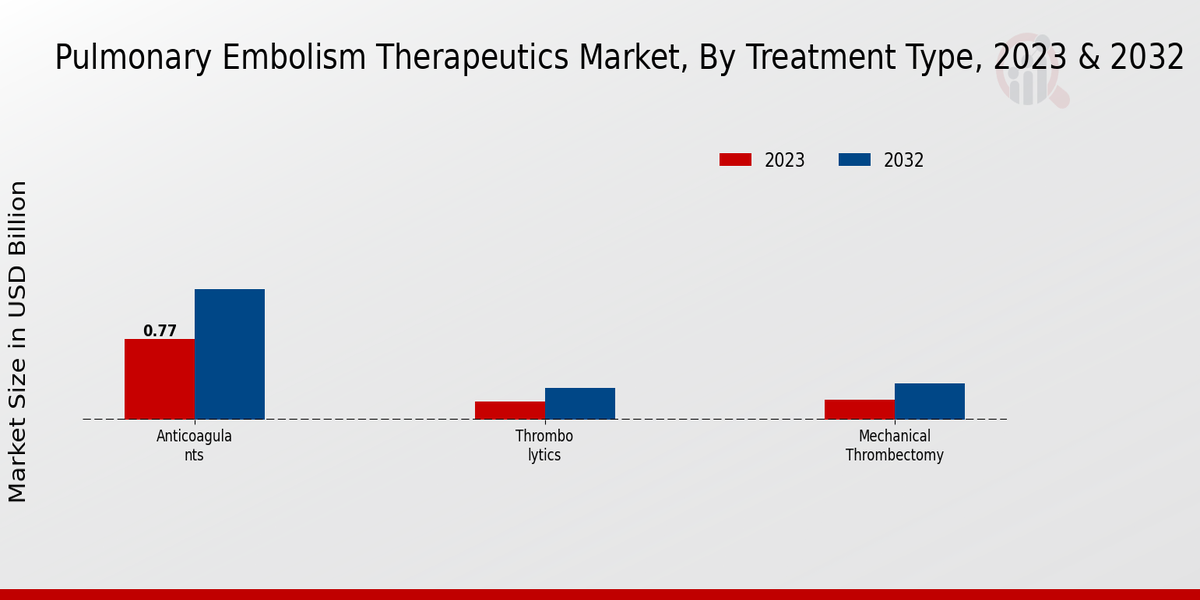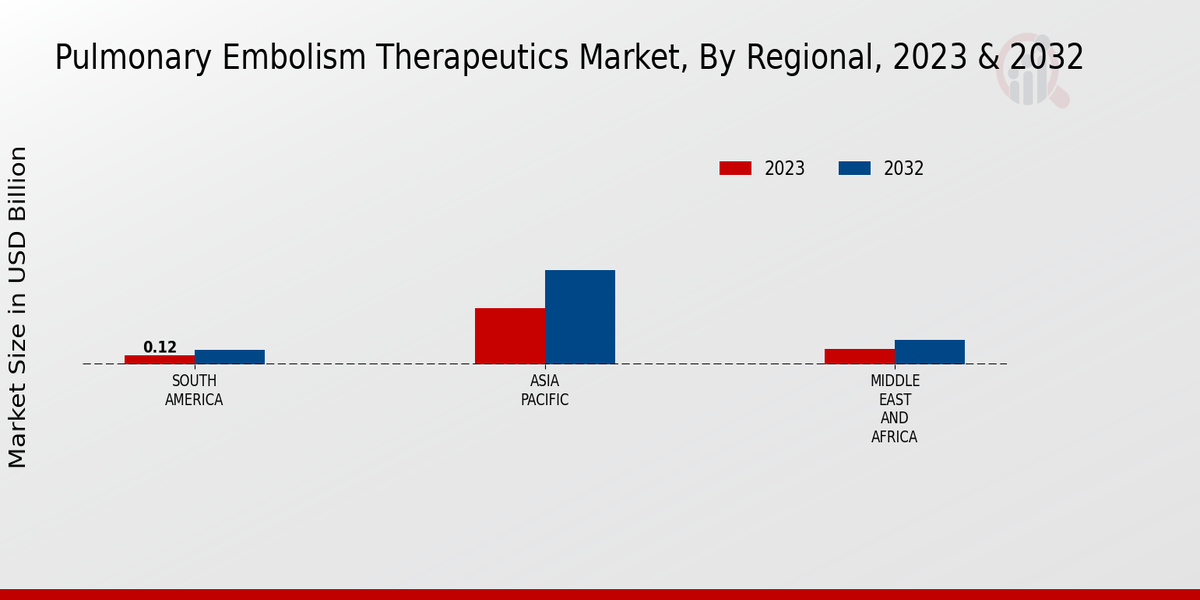Pulmonary Embolism Therapeutics Market Overview
As per MRFR analysis, the Pulmonary Embolism Therapeutics Market Size was estimated at 1.27 (USD Billion) in 2024. The Pulmonary Embolism Therapeutics Market Industry is expected to grow from 1.35 (USD Billion) in 2025 to 2.26 (USD Billion) till 2034, at a CAGR (growth rate) is expected to be around 5.92% during the forecast period (2025 - 2034).
Key Pulmonary Embolism Therapeutics Market Trends Highlighted
The global pulmonary embolism therapeutics market is projected to be driven by the increasing prevalence of pulmonary embolism. Rising incidence of deep venous thrombosis, obesity, and sedentary lifestyle are major factors contributing to the growth of the market.
Additionally, advancements in diagnostic techniques and the introduction of novel therapeutics are expected to offer lucrative opportunities for market expansion.
Recent trends indicate a shift towards anticoagulants with better safety profiles, as well as the emergence of new oral anticoagulants that offer improved convenience and reduced need for monitoring. The market is also expected to benefit from growing awareness about pulmonary embolism and the availability of reimbursement policies that cover treatment costs.

Source: Primary Research, Secondary Research, Market Research Future Database and Analyst Review
Pulmonary Embolism Therapeutics Market Drivers
Rising Prevalence of Pulmonary Embolism
Pulmonary embolism is a health condition where one or more arteries in the lungs are blocked by a clot of blood. It is a highly dangerous condition that might end fatally.
The incidence of this condition is increasing globally due to the aging population, rising rates of obesity as well as patients who are kept in the hospitals and using more medical devices. Hence, as the number of patients with pulmonary embolism increases, the demand for its corresponding treatment will increase.
Technological Advancements in Pulmonary Embolism Therapeutics
The Global Pulmonary Embolism Therapeutics Market is constantly evolving, with new and innovative treatments being developed all the time. Some of the most promising recent advancements include the development of new anticoagulants, thrombolytics, and surgical techniques. These advancements are improving the outcomes of patients with PE and reducing the risk of complications.
Growing Awareness of Pulmonary Embolism
Pulmonary embolism is a serious condition, but it is often underdiagnosed and undertreated. This is due to a lack of awareness of the condition among both patients and healthcare professionals. However, there is a growing awareness of PE, thanks to public health campaigns and educational programs. As awareness of PE increases, so too will the demand for effective treatments.
Pulmonary Embolism Therapeutics Market Segment Insights
Pulmonary Embolism Therapeutics Market Treatment Type Insights
The Global Pulmonary Embolism Therapeutics Market is characterized by its diverse treatment types, which play a crucial role in addressing this serious condition. In 2023, the market valuation for Anticoagulants was 0.7 USD Billion, making it the dominant treatment type, accounting for a substantial share of the overall market.
Anticoagulants were significant due to their efficacy in preventing blood clot formation, which is essential for treating pulmonary embolism, a condition often resulting from deep vein thrombosis. The importance of Anticoagulants is further highlighted by their projected growth to 1.15 USD Billion by 2032, indicating a majority holding within the market.
Thrombolytics also represented an essential category within the treatment types, valued at 0.25 USD Billion in 2023. These agents were critical for their ability to dissolve blood clots quickly, thus providing rapid relief to patients experiencing acute symptoms of pulmonary embolism.
The market for Thrombolytics is expected to increase to 0.45 USD Billion by 2032, although it remained smaller compared to Anticoagulants. This growth reflects the gradual acceptance of thrombolytic therapy in clinical settings, aided by advancements in drug formulations and delivery systems that improve safety and efficacy profiles.
Mechanical Thrombectomy was another treatment option that has gained attention, valued at 0.18 USD Billion in 2023, with an estimated growth to 0.3 USD Billion by 2032. This approach involved the physical removal of clots from the pulmonary arteries, making it particularly useful for patients who may not respond adequately to pharmacological treatments like Anticoagulants or Thrombolytics.
Despite being the least dominant in terms of market value, Mechanical Thrombectomy is considered a significant innovation in pulmonary embolism treatment, as it can lead to faster recovery times and reduced complications for certain patient populations.
As the Global Pulmonary Embolism Therapeutics Market evolves, the segmentation reveals insights into healthcare focus areas, trends toward less invasive procedures, and innovations that may shape future market dynamics. The variations in market valuation across these treatment types underscore the need for ongoing research and development to improve treatment efficacy and accessibility.
Overall, the Treatment Type segment showcases a competitive landscape where Anticoagulants dominate, while Thrombolytics and Mechanical Thrombectomy continue to grow, catering to specific patient needs in the realm of pulmonary embolism management.

Source: Primary Research, Secondary Research, Market Research Future Database and Analyst Review
Pulmonary Embolism Therapeutics Market Patient Population Insights
The Global Pulmonary Embolism Therapeutics Market, focusing on the Patient Population segment, showcases a diverse range of patients affected by this critical condition.
The patient population is divided into several categories, among which Patients With Symptomatic Pulmonary Embolism play a major role in driving market demand due to the higher urgency for treatment. Conversely, Patients With Asymptomatic Pulmonary Embolism, although less urgent in terms of immediate care, still represent a significant group requiring ongoing management and monitoring.
Additionally, Patients With High-Risk Pulmonary Embolism are crucial to understand, as their condition necessitates advanced therapeutic interventions, highlighting the complexity of the market. This segmentation presents opportunities for tailored therapeutic approaches, addressing the unique challenges each subgroup faces.
Overall, the Global Pulmonary Embolism Therapeutics Market reflects a focused effort on enhancing patient care, shaped by the specific needs and risks associated with various patient populations.
Pulmonary Embolism Therapeutics Market Drug Route of Administration Insights
The Drug Route of Administration segment significantly impacts patient outcomes and preferences, with various methods tailored to meet clinical needs. Intravenous administration is particularly important due to its rapid action and effectiveness in acute scenarios, making it a preferred choice for urgent treatment.
Subcutaneous administration also plays a vital role, as it allows for self-administration and ease of use, which encourages patient adherence to therapy. Moreover, the oral route presents a convenient alternative for long-term management, appealing to patients' preferences for non-invasive options.
As the market evolves, trends such as the increase in outpatient care and demand for patient-friendly therapies considerably drive the growth of this segment. Challenges include ensuring compliance and managing potential side effects associated with different routes.
Overall, the Global Pulmonary Embolism Therapeutics Market segmentation highlights the crucial interplay between administration methods and treatment effectiveness, which is essential for enhancing patient care.
Pulmonary Embolism Therapeutics Market Drug Type Insights
The Drug Type segment, which includes Direct Oral Anticoagulants (DOACs), Heparins, and Vitamin K Antagonists, plays a crucial role in this market. Among these, DOACs have gained considerable traction due to their ease of use and lower monitoring requirements, making them increasingly favored by both patients and healthcare providers.
Heparins continue to be a mainstay in acute care settings, offering rapid anticoagulation, which is critical during medical emergencies. Vitamin K Antagonists, though traditionally used, face competition from newer anticoagulants due to their dietary restrictions and monitoring needs.
As the Global Pulmonary Embolism Therapeutics Market adapts to the evolving clinical landscape, ongoing innovations and clinical research are expected to further enhance the effectiveness and acceptance of these drug types, thereby influencing overall market growth and development.
The dynamics within these categories indicate a need for tailored therapeutic strategies that can address diverse patient needs, further optimizing treatment outcomes.
Pulmonary Embolism Therapeutics Market End-Use Sector Insights
The End-Use Sector of the Global Pulmonary Embolism Therapeutics Market is a vital component as healthcare facilities play a crucial role in the diagnosis and treatment of this condition. Hospitals constitute a significant portion of the End-Use Sector as they provide comprehensive care and advanced therapeutic options, thus dominating the market.
Clinics also represent an essential segment, offering outpatient care and early intervention for patients, while Ambulatory Surgical Centers are increasingly important for performing minimally invasive procedures associated with pulmonary embolism.
The majority holding in market revenue among these facilities highlights the healthcare trend towards efficient management of conditions that require timely intervention. This sector experiences growth driven by technological advancements, the rising prevalence of lifestyle-related diseases, and increased patient awareness.
However, challenges such as reimbursement issues and the need for skilled professionals persist, providing opportunities for innovations and expansion within the market. The Global Pulmonary Embolism Therapeutics Market statistics indicate promising growth, driven by the evolving needs of these end-users.
Pulmonary Embolism Therapeutics Market Regional Insights
North America held a majority share, being valued at 0.55 USD Billion in 2023, reflecting its dominant position due to advanced healthcare infrastructure and the growing prevalence of conditions leading to pulmonary embolism. Europe followed as a significant contributor with a value of 0.35 USD Billion in 2023, benefiting from a robust regulatory framework and increased investment in healthcare.
Asia Pacific, with a valuation of 0.1 USD Billion, was gradually gaining importance as emerging economies enhanced their healthcare capabilities, indicating potential for future growth.
Meanwhile, South America, valued at 0.05 USD Billion, and the Middle East and Africa, at 0.08 USD Billion, were the least dominant regions; however, they presented opportunities for market expansion due to rising awareness and healthcare improvements.
The growth across these regions was influenced by factors such as increased diagnosis rates, advancements in therapeutics, and a rising aging population, creating a favorable landscape for the Global Pulmonary Embolism Therapeutics Market revenue growth.

Source: Primary Research, Secondary Research, Market Research Future Database and Analyst Review
Pulmonary Embolism Therapeutics Market Key Players And Competitive Insights
The industry of the Pulmonary Embolism Therapeutics Market is highly competitive, and there are several leading players in the field. The major companies that form the context of the market and that make the market dynamic include Bayer AG, Bristol-Myers Squibb Company, Boehringer Ingelheim, Merck Co., Inc., and Pfizer Inc.
All of these companies take an active part in research and development, launch their products, and cooperate strategically. The industry also involves many emerging players that concentrate on the development of new and cost-competitive forms of therapy.
In the next few years, the competitive landscape of the Pulmonary Embolism Therapeutics Market is expected to remain very dynamic and competitive, and these tendencies will be caused by the evolution of new technology and by the increasing propensity of pulmonary embolisms.
Bayer AG is a leading pharmaceutical company and one of the leading players in the Pulmonary Embolism Therapeutics Market. Bayer AG provides a variety of anticoagulants and antiplatelet agents in the sector, and the effectiveness of these products is currently being tested due to the numerous clinical trials.
Bayer AG's competitive advantage may be defined by the company's wide sales and distribution network as well as by its broad range of markets in which the company operates. The company also has strong financial performance and a great reputation in the market, as its products are well-known to customers worldwide.
Pfizer Inc. is another example of a large company that operates in the Pulmonary Embolism Therapeutics Market. Pfizer Inc. specializes in providing anticoagulants and thrombolytics as part of the treatment of pulmonary embolism.
They support their production with a wide marketing and sales network that promotes the medication among medical professionals and patients. The company's competitive advantage is determined by its good financial performance and large sales network.
Key Companies in the Pulmonary Embolism Therapeutics Market Include
- Takeda Pharmaceutical Company
- Teva Pharmaceutical Industries
Pulmonary Embolism Therapeutics Market Developments
Key factors driving market growth include the rising prevalence of pulmonary embolism, increasing awareness of the condition, and the introduction of novel therapeutic options. The market is also witnessing increasing adoption of direct oral anticoagulants (DOACs) due to their convenience and efficacy.
However, factors such as high treatment costs and potential side effects of certain therapies may restrain market growth to some extent. Recent advancements in the field include the development of catheter-directed therapies, and the exploration of gene therapy approaches for pulmonary embolism treatment. Overall, the market is poised for moderate growth in the coming years.
Pulmonary Embolism Therapeutics Market Segmentation Insights
Pulmonary Embolism Therapeutics Market Treatment Type Outlook
Pulmonary Embolism Therapeutics Market Patient Population Outlook
- Patients With Symptomatic Pulmonary Embolism
- Patients With Asymptomatic Pulmonary Embolism
- Patients With High-Risk Pulmonary Embolism
Pulmonary Embolism Therapeutics Market Drug Route of Administration Outlook
Pulmonary Embolism Therapeutics Market Drug Type Outlook
- Direct Oral Anticoagulants (DOACs)
Pulmonary Embolism Therapeutics Market End-Use Sector Outlook
- Ambulatory Surgical Centers
Pulmonary Embolism Therapeutics Market Regional Outlook
|
Report Attribute/Metric
|
Details
|
|
Market Size 2024
|
1.27 (USD Billion)
|
|
Market Size 2025
|
1.35 (USD Billion)
|
|
Market Size 2034
|
2.26 (USD Billion)
|
|
Compound Annual Growth Rate (CAGR)
|
5.92 % (2025 - 2034)
|
|
Report Coverage
|
Revenue Forecast, Competitive Landscape, Growth Factors, and Trends
|
|
Base Year
|
2024
|
|
Market Forecast Period
|
2025 - 2034
|
|
Historical Data
|
2020 - 2024
|
|
Market Forecast Units
|
USD Billion
|
|
Key Companies Profiled
|
LEO Pharma, Thrombogenics, Apotex, Boehringer Ingelheim, Actavis, Sanofi, Janssen Pharmaceuticals, Bristol-Myers Squibb, Pfizer, Bayer, Takeda Pharmaceutical Company, Novartis, Mylan, Daiichi Sankyo, Teva Pharmaceutical Industries
|
|
Segments Covered
|
Treatment Type, Patient Population, Drug Route of Administration, Drug Type, End-Use Sector, Regional
|
|
Key Market Opportunities
|
Rising prevalence of deep vein thrombosis Increasing incidence of pulmonary embolism Advancements in diagnostic techniques Growing adoption of direct oral anticoagulants Emerging novel drug therapies
|
|
Key Market Dynamics
|
Increasing prevalence of pulmonary embolism
Growing elderly population
Rising healthcare expenditure
Advancements in technology
Drug approvals and pipeline products
|
|
Countries Covered
|
North America, Europe, APAC, South America, MEA
|
Frequently Asked Questions (FAQ):
The Global Pulmonary Embolism Therapeutics Market is expected to be valued at 2.26 USD Billion by 2034.
The projected CAGR for the Global Pulmonary Embolism Therapeutics Market from 2025 to 2034 is 5.92%.
North America is anticipated to dominate the Global Pulmonary Embolism Therapeutics Market, expected to reach 0.97 USD Billion by 2032.
The market size for Anticoagulants in the Global Pulmonary Embolism Therapeutics Market is expected to be 1.15 USD Billion by 2032.
Major players in the Global Pulmonary Embolism Therapeutics Market include LEO Pharma, Boehringer Ingelheim, and Pfizer, among others.
The expected market size for Thrombolytics in the Global Pulmonary Embolism Therapeutics Market is projected to be 0.45 USD Billion by 2032.
The South American region is expected to contribute 0.09 USD Billion to the Global Pulmonary Embolism Therapeutics Market by 2032.
The projected market size for Mechanical Thrombectomy in the Global Pulmonary Embolism Therapeutics Market is 0.3 USD Billion by 2032.
Key challenges include regulatory hurdles, while opportunities lie in advancements in therapeutic technologies and the growing prevalence of pulmonary embolism.
The market size for Europe in the Global Pulmonary Embolism Therapeutics Market is expected to reach 0.61 USD Billion by 2032.

















